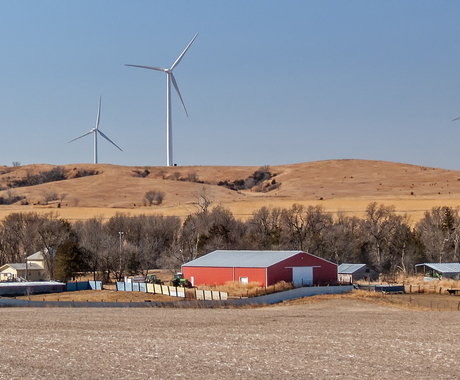By Lacie Dotterweich, former staff member
In this water quality blog series, we highlight Iowa farmers and water quality stakeholders to offer a variety of viewpoints and potential solutions.
To Don Swanson, there is no other way to farm but sustainably. This mindset started with his grandfather and was passed down to his father, then to him and his brother, Bill. It has kept the family heritage farm alive for well over a century in Ottumwa, Iowa.
“Each generation has tried to leave the ground better for the next generation, which is our goal,” said Don.
The brothers believe using sustainable practices that keep soil and water healthy is essential to carry on the family farm, like it has been for the past 170 years.
Don uses a wide array of conservation practices to keep soil in his fields, and not in local water sources. He keeps much of his ground seeded down with a legume grass mix for cattle to graze, and plants cereal rye cover crops. He also implements thousands of feet of terraces, has built half a dozen ponds, keeps many grass waterways, and practices no-till.
“We were doing conservation practices before it was cool to do it; we’ve been doing no till and cover crop and rotation and big grass waterways for years,” said Don.
These methods make a huge difference in keeping soil and nitrates out of the water.
Water quality is a big issue in southeast Iowa. Soils there are subject to heavy erosion which can lead to large amounts of runoff into lakes, rivers, and streams. On Iowa’s farms, there are two main nutrients that can leach into bodies of water: nitrates and phosphates.
Nitrates can come from fertilizers, the soil, and other sources, such as stormwater drainage, and typically migrate with fast-moving water. Phosphorus tends to move with solid substances like manure or soil.
Nutrient runoff from farm fields causes issues when it comes to clean drinking water, marine life, and recreation. Notably, nutrients can rapidly increase the growth of algae in waterways. Upon death, the algae depletes oxygen in the water, which can make it impossible for marine life to flourish. These areas with depleted water oxygen levels are called hypoxic zones, or dead zones.
Iowa agriculture is a big culprit in the creation of the dead zone in the Gulf of Mexico, which is now the size of New Jersey. In 2016, a study from the University of Iowa showed the state's input to the dead zone increased by 47 percent, to 618 million pounds. The depletion of oxygen makes it very hard for aquatic life to survive, forcing fish and other sea creatures to move farther out into the Gulf to find habitats and oxygen. Another negative side effect: people in the fishing industry must go farther and farther to catch anything, leaving an impact on rural Gulf communities.
Don believes we, as Iowans, can do a much better job of reducing nutrient runoff. What sets the Swansons apart is how they care for their farm.
“We take care of our rented ground like we would if we owned it; it costs us more in the short term but is worth it in the long run,” said Don.
The brothers’ views on stewardship influence much of their approach to conservation practices.
Don’s philosophy is all about stopping the water. He uses a multi-step process to curb runoff water from draining into nearby Buckeye Creek. First, his cover crop roots do a good job of retaining the water and nutrients in the soil. Any water that does begin to drain is slowed down by seeded grass waterways where it then flows into a low lying pond that he built. His small pond then drains into a larger neighboring pond with dams in place to contain the water.
These ponds allow sediment, often carrying nitrates and phosphates, to settle out of the water and back into the soil where they were intended to be. Ponds like these are often referred to as water sediment basins and have been proven to significantly reduce nutrient leaching.
Don hopes to do more in-field water testing to benchmark what comes out in the spring, and what comes out in the fall. This allows the Swansons to evaluate which nutrients are leaching more frequently, and informs them about which practices they can implement to reduce their impact on water quality. This would help indicate if he is causing problems or not.
For farmers wanting to get started on soil and water conservation practices, Don advises starting small and trying different things. He says it is important to stay educated and always look for opportunities to learn more.
“We need to accept that we are all in this together,” he said. “Everyone needs to help.”
Improving water quality through coordinated efforts
Many Iowa farmers, like Don, are trying their best to curb farm runoff. Cover crop acres are growing, and more conservation practices are being installed, but there is still room for improvement. We must all work together to plant more cover crops, restore wetlands, and install other practices on Iowa’s landscape.
Coordinating efforts with one another and electing officials who are serious about improving water quality would put us in much better shape. Creative solutions such as a tax credits for conservation, funding the Natural Resource and Outdoor Recreation Trust Fund, or investing in watershed management authorities are needed if real progress is to be made.
Feature photo: Don Swanson (right) and his brother, Bill, are general partners of Swanson Farm Partnership, a diversified grain and livestock operation in Wapello and Lucas counties. | Photo by Lacie Dotterweich





